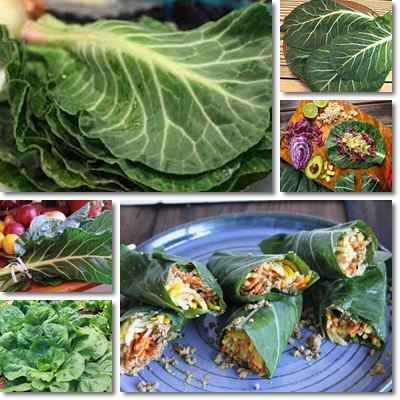Collard greens or simply collards (Brassica oleracea Acephala) is a beloved cultivar of the cabbage family, bred from the wild cabbage plant. Collards distinguish themselves from other cruciferous vegetables through their loose, large, thick leaves and enjoy great popularity in cuisines worldwide. The name collard greens denominates the leafy green part of the collard plant and is a preferred name because it refers precisely to the parts used for cooking.
Moreover, the name is often preferred over the simple ‘collards’ because the entire plant is mostly large leaves attached to a stem. Dalmatian cabbage is another common name for the species and hints at the ancestry of the vegetable, the wild cabbage plant. The vegetable is an incredibly healthy leafy green, rich in vitamins K and A, B vitamins, dietary fiber and naturally-occurring sulfur compounds, all of which contribute to strong bones, good eyesight, good immunity and boast cholesterol-lowering and anticancer properties.

What do collard greens look like?
Collard plants look a lot like very loose cabbages with extremely large and fine green, thick leaves with visible white veins and white-green stems. Due to their close resemblance to other cruciferous vegetables, the leaves (the collard greens) are often mistaken for kale when cut. However, kale leaves are curly, with tiny, soft bumps on their surface and quite different-looking compared to collard greens.
What do collard greens taste like?
Collards have a distinct bitter taste, similar to Brussels sprouts. Picking the leaves after the first frost makes them more palatable as the bitter compounds react to the low temperatures in an attempt to protect the plant, resulting in a more pleasant taste. Young collard greens have a much more manageable texture, while leaves left to mature often need to be cooked longer to soften. Collards are a beloved American leafy green, commonly used as a side dish.
They are often cooked together with other vegetable greens such as mustard greens, turnip greens, kale or spinach or eaten stuffed with either meat or rice.

What are the benefits of collard greens?
Anticancer properties
Research on the cancer-preventive properties of cruciferous vegetables has shown that collard greens contain glucosinolates, natural sulfur-containing compounds. Glucosinolates have been found to offer protection against several types of cancer such as lung and digestive tract cancers (Glucosinolates: bioavailability and importance to health). Apparently, chewing releases a special enzyme which causes glucosinolates to release isothiocyanates, derivate compounds that can inhibit proliferation as well as induce programmed cell death in cancer cells. Other foods with similar cancer-protective effects include cabbage, broccoli, cauliflower, kale, onions, garlic, mustard green etc.
Offers antioxidant protection
Collard greens have been found to contain potent antioxidant compounds, notably the antioxidant-mineral manganese, the flavonoids kaempferol and quercetin, not to mention powerful isothiocyanates (Identification of the phenolic components of collard greens, kale, and Chinese broccoli). Antioxidants protect cells and DNA against free radical damage that could disrupt normal cell activity and cause them to mutate, potentially leading to cancer.
Helps lower cholesterol levels
According to research, collard is one of several vegetables to bind to bile acid, encouraging its elimination. Bile acid is actually fat, cholesterol. This means that foods such as collard greens, which support the elimination of bile acids, actually help lower cholesterol levels in the blood.
The same study also asserts that steaming is the best way to enhance the cholesterol-lowering abilities of collards (Steam cooking significantly improves in vitro bile acid binding of collard greens, kale, mustard greens, broccoli, green bell pepper, and cabbage).
Boasts an incredible vitamin K content
100 g of collard greens provides about 4 times the RDA of vitamin K (over 405 µg). Vitamin K is essential for preventing the calcification of blood vessels and thus maintaining cardiovascular health. Moreover, it promotes bone health and supports blood coagulation.
Nevertheless, watch your vitamin K and leafy greens intake very carefully if you are taking anticoagulant medication. The fact that you have to take anticoagulants means you are already predisposed to experiencing blood clotting and blood clots and foods rich in vitamin K such as collards will further magnify that risk, putting you at risk for life-threatening conditions.
Great source of dietary fiber and low in calories
100 g of collards provides about 4 g of dietary fiber. Dietary fiber binds to fats in the digestive tract, preventing the body from absorbing all of them. This, in turn, contributes to lower LDL (bad) cholesterol and triglyceride levels as well as promotes weight loss. With only 30-33 kcal/100 g, collards are great for a healthy weight loss diet.
Relieves constipation and promotes colon health
The dietary fiber in collard greens adds bulk to stools, facilitating their elimination and helping relieve constipation naturally. This, in turn, results in a healthier colon due to the fact that it is less exposed to toxins from waste material and also benefits for hemorrhoid disease, or piles.
B vitamins, calcium and vitamin A
Collard greens are a good source of B vitamins such as vitamins B1, B2, B3, B5, B6 and B9. B vitamins help improve digestion by facilitating the synthesis of macronutrients from food and contributing to the production of energy, resulting in elevated energy levels. The vegetable’s calcium content (around 20% of the RDA) contributes to healthy bones and teeth.
Like most green, leafy vegetables, collard greens are a great source of vitamin A and provitamin A carotenoids such as beta-carotene, lutein and zeaxanthin. All of these nutrients combined ensure good vision and healthy eyesight and protect against degenerative eye conditions such as macular degeneration.
Tonic properties
Last but not least, collard greens make a great tonic food, meaning they restore energy and contribute to a state of wellbeing. Such effects stem from the vegetable’s overall generous vitamin and mineral content. Adding a large collard leaf to your favorite smoothie has just become a smart move.
